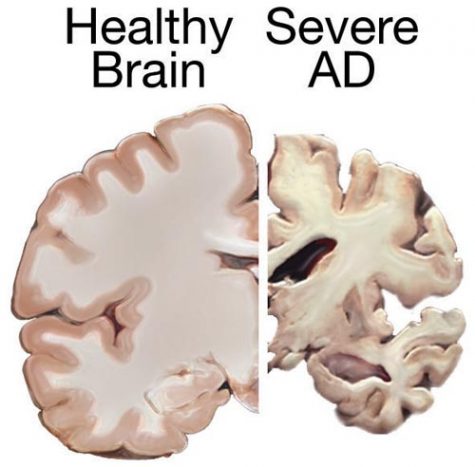Alleviating Alzheimer’s

Alzheimer’s disease is a neurodegenerative dementia that lowers brain mass and includes symptoms of short term memory loss, loss of coordination, among other things.
Alzheimer’s disease has always been an alluding issue within the psychological and medical health fields. A widespread disease with no known way to reverse its devastating symptoms, it is a challenging obstacle for the advancement of medical knowledge. Atrophying brain mass and destroying memory over time, AD (Alzheimer’s Disease) cripples its victim mentally, bringing grief to families, and takes away the ability of an individual to take care of themselves progressively over many years. Not only that, AD is just one of the many types of degenerative dementia that degrade the mind.
With its supposed invulnerability to any sort of therapy or treatment, scientists have found links between symptoms and events in the brain related to aging. The accumulation of Tau clumps, amyloid beta, among other compounds in the brain have been shown to be linked to neurodegenerative diseases. With this knowledge, AD researchers have been trying to grasp understanding of dementia in hopes to synthesize a drug that will reverse symptoms. Any discovery found could be life changing for the 3 million victims and their families that dementia clutches per year.
Many drugs can still be prescribed to patients that may alleviate some symptoms of dementia temporarily. A push has started though, with newfound knowledge of the drug, to find the cure. Many promising methods have arrived, based on different hypotheses for the causes of Alzheimer’s. One drug, based on the Tau Hypothesis, uses oligonucleotides to untangle the supposed neurofibrillary tangles that destroy the cytoskeleton structure that holds together the brain. In more detail, the Tau hypothesis proposes that the cause of Alzheimer’s is associated with abnormalities with the Tau protein, a protein which stabilizes microtubules in the central nervous system, when the Tau protein becomes hyperphosphorylated, that is, when the protein has all of its phosphorylation sites saturated. The hypothesis states that then the hyperphosphorylated protein creates tangles which eventually dissolve, destroying the structure of the cell’s cytoskeletons, leading to the eventually death of brain cells.
The drug uses oligonucleotides, short sequences of DNA or RNA, to shut the Tau gene off. Using the drug by injecting it into the fluid filled brain cavities of older mice, results were seen in less Tau production and accumulation, opening a door into Alzheimer’s therapy. With FDA approved antisense oligonucleotide therapy already being used for many neurological diseases.
Although at many times, new drugs may seem promising, often they are not. Solanezumab, another Alzheimer’s drug based on the Amyloid Beta hypothesis, bonded with Amyloid beta proteins to reduce protein accumulation, which is suspected to lead to Alzheimer’s. However, after three trials and much anticipation, the drug showed almost no improvement in cognitive function with patients. With the amyloid hypothesis having the most following, this was a large disappointment to the Alzheimer’s research community as a whole.
Alzheimer’s is a strange disease, inflicting many but cured by nobody. With health technology advancing with CRISPR, antisense oligonucleotide therapy, and computer drug simulations, hopefully Alzheimer’s may be cured like other diseases. Nevertheless, these compounds must be tested for safety of the user, and effectiveness.





